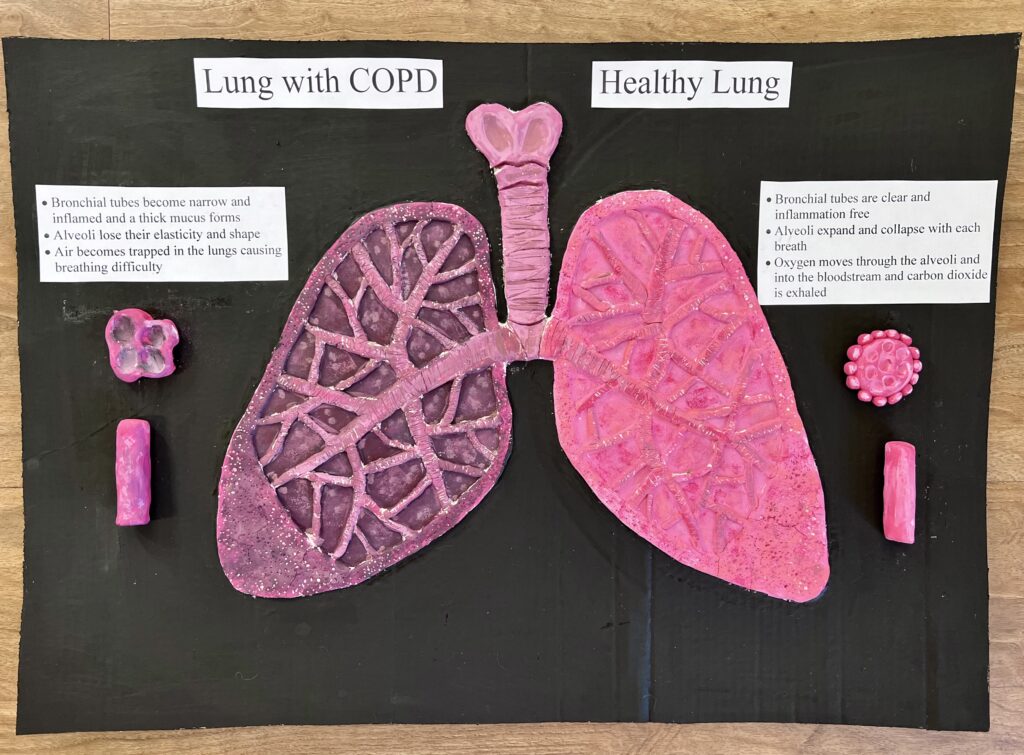
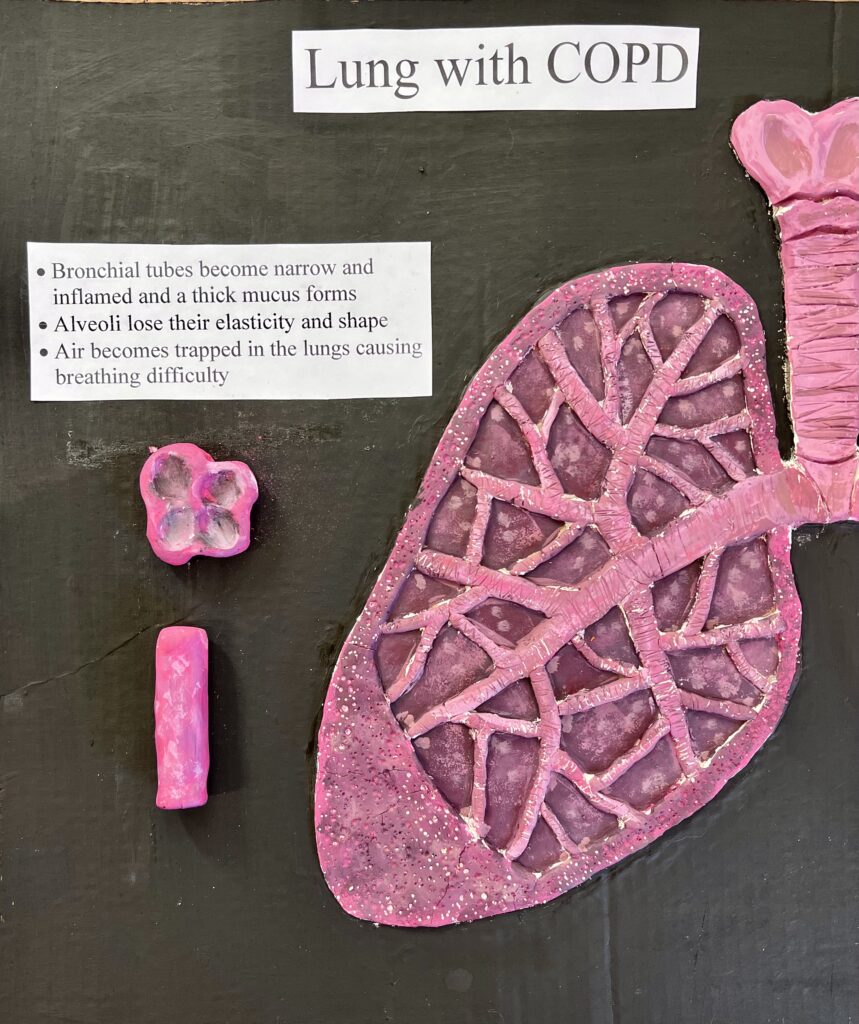
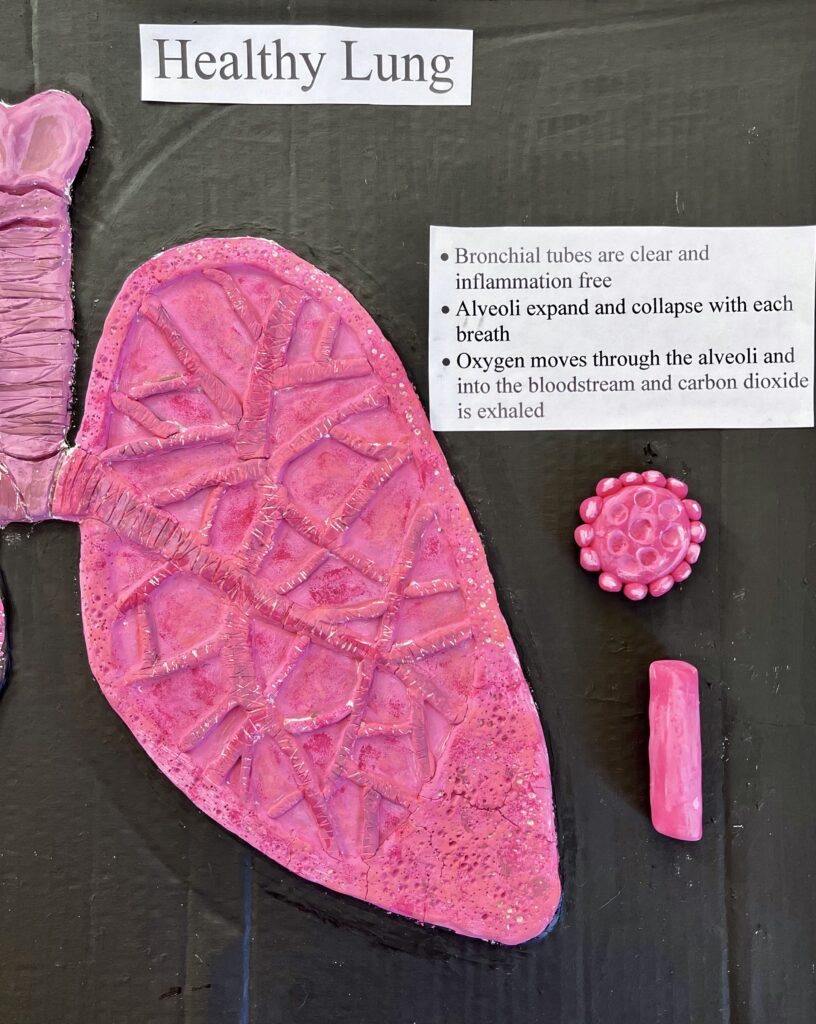
This project analyzes causes, symptoms and treatments of Chronic Obstructive Pulmonary Disease and the effects it has on the function and structure of the respiratory system. COPD is a progressive inflammatory airway disease characterized by perpetual restriction of airflow and related respiratory symptoms, due to damage to the airway and alveoli in the lungs (Jo). However, COPD isn’t just a pulmonary disease, it’s also a systemic inflammatory disorder. Things like muscular weakness, increased risk for atherosclerotic vascular disease, depression, osteoporosis, and abnormalities in fluids and electrolyte balance may also be additional consequences of COPD (Jo).
The right side of the lung model shows healthy lungs. Here, the air that is breathed in travels through the bronchial tubes, which branch off into thousands of smaller, thinner tubes called bronchioles. A series of smaller arteries and arterioles eventually lead to the pulmonary capillaries. The pulmonary capillaries surround clusters of tiny round air sacs known as alveoli that are the sites of oxygen and carbon dioxide exchange. The alveoli are elastic and stretchy and have very thin walls full of capillaries. The oxygen that is inhaled passes into these capillaries and enters the bloodstream. At the same time, carbon dioxide is exhaled. The lungs rely on the natural elasticity of the bronchial tubes and alveoli to force air out of the body. As shown on the left side of the model, COPD causes the bronchial tubes and alveoli to lose their elasticity and over-expand, which leaves air trapped in the lungs when exhaling. Cigarette smoking is the leading cause of COPD (“What Is COPD?”). Long-term smoking or exposure to tobacco smoke and other air pollutants damage the tissues, lungs and airways.
The diagnosis is of COPD is confirmed by spirometry, a walk test, laboratory testing, and radiographic imaging and typically includes two main conditions: emphysema and chronic long-term bronchitis (Agarwal). Usually, people with COPD have both emphysema and chronic bronchitis, but the severity of each condition varies from person to person. Emphysema develops when there is significant damage to airways distal to the terminal bronchiole, including the respiratory bronchiole, alveolar sacs, alveolar ducts, and alveoli, together are known as the acinus (Pahal). Over time, the alveoli become extremely weak and eventually rupture, creating large air pockets called bullae, instead of many small ones. This reduces the overall surface area of the lungs and negatively affects the amount of oxygen that reaches the bloodstream. During exhalation, the damaged alveoli don’t work properly and air becomes trapped, leaving little space for oxygen-rich air to enter. The damage to the alveoli and airway make it difficult for the exchange of carbon dioxide and oxygen during each breath. Decreased levels of oxygen in the blood and increased levels of carbon dioxide cause the muscles that control the lungs to contract harder and faster than normal. The nerves in the muscles and lungs sense this increased activity send signals to the brain, and this is what causes the feeling of shortness of breath. Chronic bronchitis refers to long-term inflammation and irritation of the bronchi that is caused by overproduction and hypersecretion of mucus by goblet cells (Widysanto). Epithelial cells lining the airway react to toxic, infectious stimuli by releasing inflammatory mediators (Widysanto). This inflammation causes thick mucus to form which makes it difficult for the lungs to take oxygen in and carbon dioxide out of the body. COPD can cause excessive coughing that produces large amounts of mucus. It can also cause difficulty breathing, shortness of breath, chest tightness, and other respiratory symptoms. Symptoms of COPD often develop slowly but can worsen over time, making everyday activities extremely difficult.
Although there is currently no cure for COPD, treatments and lifestyle changes can help to control symptoms, slow progression, reduce risk of complications and exacerbations, and improve a person’s quality of life (“COPD”). For people who smoke, quitting is the most important first step to help slow the progression of this disease. Medication like bronchodilators, steroids and combination inhalers can be taken to help treat COPD symptoms. Lung therapies can also help treat symptoms. Oxygen therapy can be used if there isn’t enough oxygen in the blood. Some people with COPD only need supplemental oxygen during physical activities or during sleep, while others may need it all the time. Pulmonary rehabilitation after episodes of worsening COPD can also reduce readmission to the hospital and increase and person’s ability to participate in everyday activities(“COPD”). Surgery may be an option for people with severe forms of COPD when medications alone aren’t working sufficiently. Surgical options include, lung volume reduction surgery, lung transplants, and Bullectomies.
COPD progresses at a different rate and intensity for every person, but once it progresses, the lung damage cannot be reversed or cured. People with COPD are at higher risk of other serious health problems, so it is important to lead a healthy lifestyle and receive the necessary treatment as early as possible to help to slow the progression and reduce symptoms of COPD.
Works Cited
Agarwal, Anuj k, et al. “Chronic Obstructive Pulmonary Disease.” Statpearls – NCBI Bookshelf. Chronic Obstructive Pulmonary Disease, https://www.ncbi.nlm.nih.gov/books/NBK559281/.
Widysanto, Allen, and George Mathew. “Chronic Bronchitis – Statpearls – NCBI Bookshelf.” Chronic Bronchitis, https://www.ncbi.nlm.nih.gov/books/NBK482437/.
“COPD.” Mayo Clinic, Mayo Foundation for Medical Education and Research, 15 Apr. 2020, https://www.mayoclinic.org/diseases-conditions/copd/diagnosis-treatment/drc-20353685.
Jo, Yong Suk. “Long-Term Outcome of Chronic Obstructive Pulmonary Disease: A Review.” Tuberculosis and Respiratory Diseases, U.S. National Library of Medicine, Oct. 2022, https://www.ncbi.nlm.nih.gov/pmc/articles/PMC9537656/.
Pahal, Parul, et al. Emphysema, U.S. National Library of Medicine, https://pubmed.ncbi.nlm.nih.gov/29489292/.
“What Is COPD?” National Heart Lung and Blood Institute, U.S. Department of Health and Human Services, https://www.nhlbi.nih.gov/health/copd.
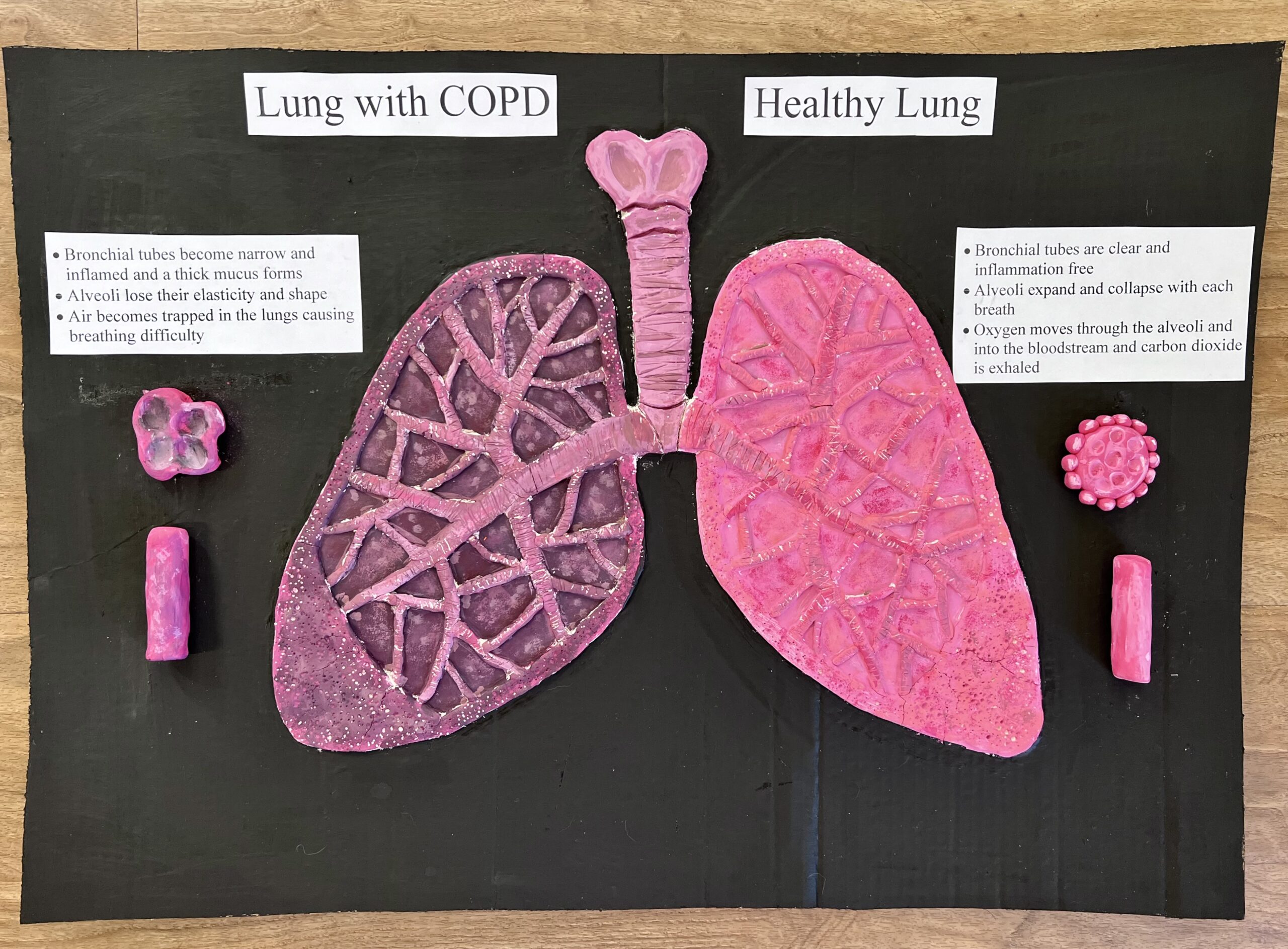
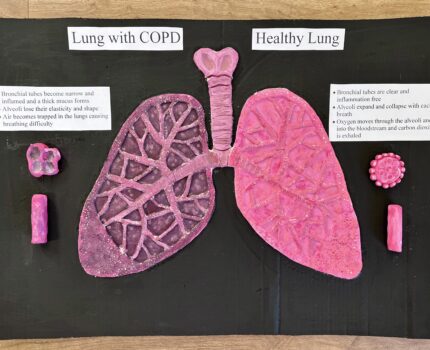
Raquel’s STEAM project focuses on a holistic view of Chronic Obstructive Pulmonary Disease (COPD) including what causes it, its symptoms, and treatments along with the effects COPD has on the function and structure of the respiratory system. COPD is a condition with ongoing limitations of airflow and related respiratory symptoms caused by the damage to the airway and alveoli in the lungs. Her media depicts a healthy right side lung with air traveling normally and more prevalent is the tubes and alveoli having their elasticity for normal airflow. On the left side of the lung depicts COPD causing the tubes and alveoli losing their elasticity which leaves air trapped in the lungs when it expands. Cigarette smoking is the number one cause of COPD due to long-term exposure to tobacco smoke along with other air pollutants. Normally individuals with COPD show both emphysema and chronic bronchitis with the severity of the condition varying from person to person. Emphysema occurs with people who have COPD due to damage to airways distal to the terminal bronchiole known as the acinus and with time, the alveoli become weak and eventually bust, causing large air pockets instead of small ones known as bullae. This affects the amount of oxygen that reaches the bloodstream and when exhaling, damaged alveoli do not function properly and cause air trapped. Chronic Bronchitis is continuing inflammation and irritation to the bronchi caused by overproduction and hypersecretion of mucus goblet cells. Due to toxicity, the epithelial cells react to this through the release of inflammatory mediators and the inflammation causes dense mucus formation making it hard for the lungs to inhale oxygen and exhale carbon dioxide. COPD causes unnecessary coughing producing mucus, difficulty of breathing, chest tightness as well as other respiratory symptoms with them developing moderately but can worsen with time. COPD is incurable but treatment includes lifestyle changes that help control symptoms, slow its progression, and lower risks of complications including quitting smoking. There are medications available such as bronchodilators, steroids and a combination of inhalers to help treat COPD symptoms.